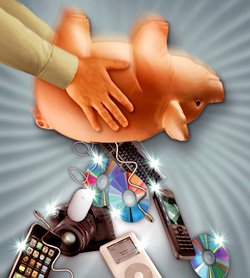Students Make Their Case in Colorado
Teenagers videoconference about a school district’s book-adoption policy.
Your content has been saved!
Go to My Saved Content.
While their fellow students in schools around the country hunkered down over traditional final exams, ninth graders at Arapahoe High School, in Centennial, Colorado, took part in a spirited year-end conversation about literature, technology, and civil liberties.
From seven time zones away, London-based sci-fi author Cory Doctorow joined in via videoconference to talk about his futuristic novel Little Brother, which the students had read for an English assignment. Parents, teachers, and interested school board members were able to participate, too, because they streamed the conference live.
Best of all, according to Arapahoe technology director Karl Fisch, the experience came about because of student initiative: Enterprising ninth graders tracked down the author via email and invited him to chat in real time. It's the kind of thing that happens naturally, Fisch says, "when students expect to be connected learners."
Fisch, a recent winner of the Outstanding Leader award from the International Society for Technology in Education, acknowledges that such powerful learning experiences are not yet the norm in public schools across the country; many barriers prevent teachers and students from taking full advantage of what technology has to offer. But teachers can overcome these barriers without waiting for seismic shifts in policy or in technology funding.
One can find examples of teachers accomplishing effective tech integration using normal budgets and with all kinds of students. And, most important, others can easily replicate these successes.
The videoconferencing project at Arapahoe began with a dystopian literature assignment. English teachers Anne Smith and Maura Moritz asked ninth graders to make their best case for why the school board should approve or ban certain controversial titles such as I, Robot, Anthem, and 1984.
This activity was a simulation, but to make the assignment more authentic, school board members agreed to listen to students' arguments and pose questions based on the school district's book-adoption guidelines. On his popular blog the Fischbowl, Fisch recruited more educators from outside the district to take part via videoconference.
Once they read their selected books, student teams turned to technology as they prepared their final arguments. (Arapahoe students have ready access to tech tools for communicating and connecting, including classroom computers and a media lab they can use when they aren't in class.)
Some students did online research to gain a better understanding of the context for the book they had selected. Smith's class wiki gave teams an online space where they could collaboratively plan their presentations, which included visuals along with oral arguments.
Students also had to be ready to think on their feet and respond to questions from the virtual school board. One team decided to email an author to solicit additional information, and that's where the conversation with writer Cory Doctorow came in.
The live author interview was not a planned part of the project, but it used technology tools Smith and Fisch had previously tapped for other classroom events: Skype (a free videoconferencing application) and a webcam, Ustream for free live streaming and archiving, and Twitter to publicize the chat and to receive questions and comments in real time from remote listeners.
"None of it is very complicated," notes Fisch, whose role as technology director includes, he says, making sure everything works.
The project offers a good illustration, he adds, of how student learning unfolds in a school that has deliberately integrated technology and provided teachers with professional development to foster more student-centered learning. "Our kids know we have the technology, and they know they have a teacher and a school that will say yes to their ideas," he explains.
Suzie Boss is coauthor of Reinventing Project-Based Learning: Your Field Guide to Real-World Projects in the Digital Age. She also blogs for Edutopia.org.
This article is the first of four that describe how schools integrate technology without spending a lot of money. Next, read how a New York school uses classroom tech tools on a budget.